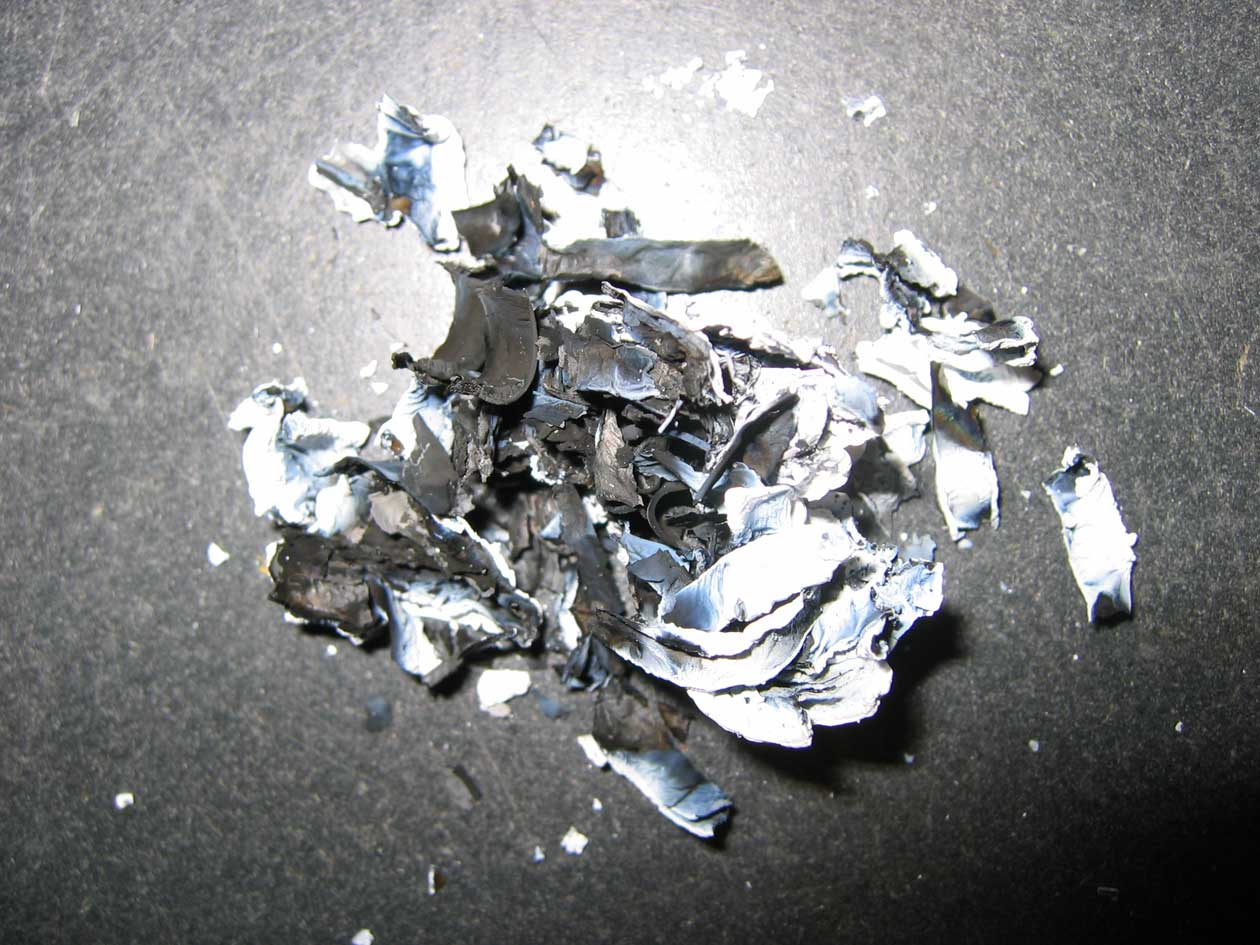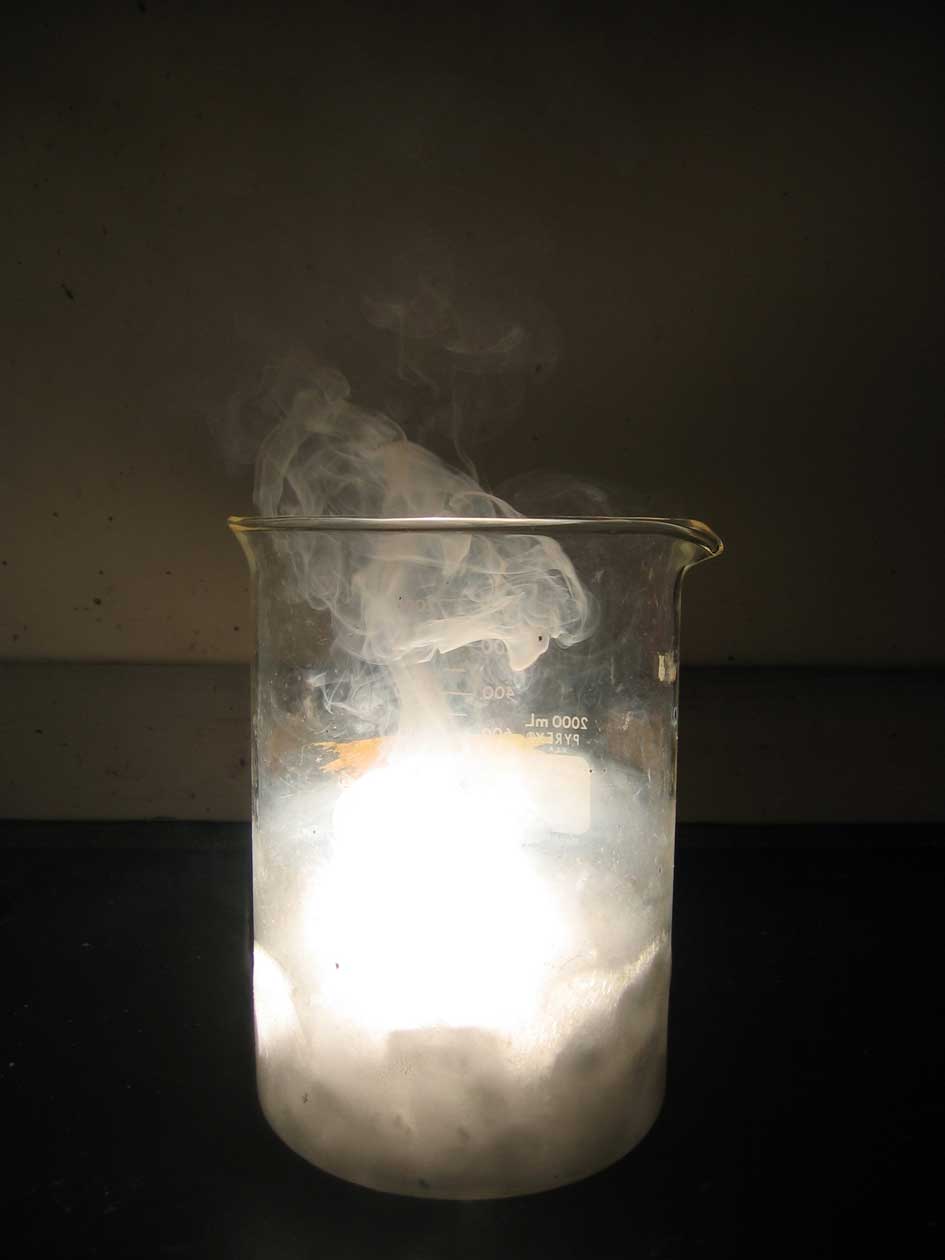 What is going on? Magnesium metal exposed to the air will slowly oxidize over time. Heating the metal dramatically accelerates the reaction of metallic
magnesium with the oxygen in the air. The reaction is
What is going on? Magnesium metal exposed to the air will slowly oxidize over time. Heating the metal dramatically accelerates the reaction of metallic
magnesium with the oxygen in the air. The reaction is
The oxygen thief
 Magnesium wire is found to burn ferociously in air, producing a brilliant white light.
Magnesium wire is found to burn ferociously in air, producing a brilliant white light.
Ingredients: magnesium wire, metal rod or tongs, lighter or propane torch
Procedure: A complete recipe follows.
1. Take a six inch strip of magnesium wire. Hold the wire with tongs or simply wrap an end around a metal rod.
2. Light the magnesium wire with a match. Be patient - it might take a few seconds to get the oxidation started.
3. Be careful not to stare directly at the wire from a close distance - the light is very bright.
Understanding: This simple experiment consists of lighting a magnesium wire in the air to produce a brilliant white light. If you love pyrotechnic displays, you will recognize the white light of the magnesium, a common source of bright white light in fireworks.
 What is going on? Magnesium metal exposed to the air will slowly oxidize over time. Heating the metal dramatically accelerates the reaction of metallic
magnesium with the oxygen in the air. The reaction is
What is going on? Magnesium metal exposed to the air will slowly oxidize over time. Heating the metal dramatically accelerates the reaction of metallic
magnesium with the oxygen in the air. The reaction is
2 Mg(s) + O2(g) → 2 MgO(s)
where magnesium metal is oxidized and the dioxygen from the surrounding air is reduced resulting in a soft, white powder of magnesium oxide.At the level of atoms and molecules, a magnesium atom at the surface of the metal wire will meet a molecule of dioxygen. Oxygen is electronegative. That doesn't mean that it has a negative view of electrons - in fact, it loves them. In this reaction, the oxygen takes electrons from the magnesium, leaving the magnesium oxidized and the oxygen reduced (in charge, for taking on the electrons).
The reaction is highly exothermic, producing a good deal of heat and a blinding white light. While we needed to heat the wire to start the reaction, the heat produced is sufficient for the reaction to continue until the full wire is oxidized.
Ingredients: magnesium wire, slab of dry ice, a large beaker,
lighter or propane torch
Procedure: A complete recipe follows.
1. Fill a large beaker with dry ice (solid carbon
dioxide). Wait for a
time so that the dry ice sublimates, displacing the air in the
beaker with carbon dioxide.
2. Take a six inch strip of magnesium wire. Hold the wire
with tongs or simply wrap an end around a metal rod.
3. Light the magnesium wire with a match. Be patient - it
might take a few seconds to get the oxidation started.
4. Lower the burning wire into the beaker. The wire will begin
to sputter. Do be sure to hold the wire at a
distance - the light is very bright.
The reaction that occurs is
2 Mg(s) + CO2(g) → 2 MgO(s) + C(s)
The oxidation of the magnesium wire in air taught us that metallic magnesium
atoms love to be oxidized. In this reaction, we find that the driving
force for magnesium oxidation is so great that is can tear the bonds
between the carbon and oxygen atoms asunder, generating magnesium oxide
and elemental carbon.
This reaction is remarkable for a number of reasons. Carbon dioxide is most commonly produced as a product of redox combustion reactions. In this case, it is a reactant! You may know that carbon dioxide is often a principle component of fire extinguishers. Here it is fuel for the fire. Don't use a CO2 fire extinguisher on a magnesium fire!
 Magnesium wire, observed to burn ferociously in air, also burns in a Martian atmosphere of carbon dioxide.
Magnesium wire, observed to burn ferociously in air, also burns in a Martian atmosphere of carbon dioxide.
 Understanding:
When you observe the product of your reaction, you will find the white
powder of magnesium oxide mixed with black bits. What are the black
bits? Elemental carbon!
Understanding:
When you observe the product of your reaction, you will find the white
powder of magnesium oxide mixed with black bits. What are the black
bits? Elemental carbon!